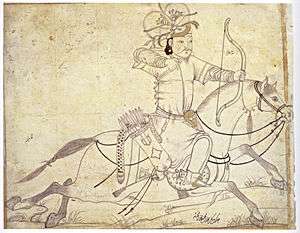Mongol bow

The Mongol bow is a type of recurved composite bow used in Mongolia. "Mongol bow" can refer to two types of bow. From the 17th century onward, most of the traditional bows in Mongolia were replaced with the similar Manchu Bow which is primarily distinguished by larger siyahs and the presence of prominent string bridges.
.jpg)
Pre-Qing Mongol Bow
The old Mongolian bows that were used during the rule of Genghis Khan were smaller than the modern Manchu derived weapons used at most Naadam. Paintings as well as at least one surviving example of a 13th century Mongol bow from Cagaan Chad demonstrate that the medieval Mongolian bows had smaller siyahs and much less prominent leather string bridges.[1]
Influence of the Qing Dynasty
From the 17th-20th century, horseback archery in Mongolia (and around the world) declined in prominence in proportion to the availability of firearms. Contemporary depictions of the 1768 Battle of Khorgos between the Qing Dynasty and the Western Mongolian Dzungars show the mounted Dzungars primarily armed with muskets. Despite changes in bow construction over time, the Mongolian archery tradition has been continuous. The traditions of Mongolian archery were partially kept alive by the Qing Imperial court which maintained a cohort Mongolian Imperial Bodyguards specifically trained in archery with Manchurian bows. Gradually, construction of composite bows in Mongolia, China, and Tibet largely shifted to Manchu derived designs to the point where the traditional "Mongolian bow" used in the Nandaam festival actually derives from the Manchu popularized design [2]
Construction

Ancient and modern Mongol bows are part of the Asian composite bow tradition. The core is bamboo, with horn on the belly (facing towards the archer) and sinew on the back, bound together with animal glue.[3] As animal glue is dissolved by water, composite bows may be ruined by rain or excess humidity; a wrapper of (waterproof) birch bark may give limited protection from moisture and from mechanical damage. The bow is usually stored in a leather case for protection when not in use.
The arrows
Birch is a typical material for arrows. The normal length of an arrow is between 80 and 100 cm, and the shaft's diameter is around 1 cm.
As for fletchings, tail feathers of crane are favored, but tail feathers of all birds are usable. Eagle feathers make a particularly exclusive arrow, but since eagles are rare most arrows obviously cannot have fletchings from eagle's tail feathers. Feathers taken from the wings are said to flow less smoothly through the air, so if given the choice tail feathers are picked. The Mongols characteristically pay close attention to minutest of detail; the placement of the fletchings in relation to their size, and what part of the bird they were taken from, is of great importance for correct rotation and good balance in the air. Consequently, these factors are painstakingly considered when making arrows after the Old Mongol standard.
The arrowheads, or points, could be everything from wide metal blades used for big game (or in war) to bone and wooden points, which are used for hunting birds and small animals. The high impact of this bow ensures that a bony point will be lethal when hitting the body of a smaller animal or a bird. In addition to these kinds of arrows, whistling arrows are useful during hunting, because the effect on animals of an arrow whistling away high above the ground is often to make it stop, curious to see what is in the air. This gives the hunter time to launch a second arrow, this time with a game head to kill the animal. These whistling arrows made by inserting an arrowhead of bone in which air channels have been created. When shot, such arrowheads make a very audible sound through the air.
Range

An inscription thought to be from 1226 was found on a stone stele in Nerchinsk, Siberia. It may have said: "While Chinggis Khan was holding an assembly of Mongolian dignitaries, after his conquest of Sartaul (East Turkestan), [Chinggis's nephew] Esungge shot a target at 335 alds (536m)."[4]
In the historical novel "Khökh Sudar" Injinashi, the Mongolian philosopher, historian and writer, imagines the competition amongst all Mongolian men in about 1194-1195: five archers each hit the target three times from a distance of 500 bows (1 bow = at least 1 metre).
Mongolian draw and release

The Mongolian draw, or thumb draw, uses only the thumb, the strongest single digit, to grasp the string. Around the back of the thumb, the index and/or middle fingers reinforce the grip. This is traditional across the Asian steppes, as well as in Korea,[5] Japan, Tibet, China, Turkey, India and recent Persia.[6] It was also used by Ishi, the last of the Yana, with his short bows.
It gives a narrower grip on the string, as only one digit is used, and this may help to avoid "string pinch" with shorter bows, such as the composite bows normally used from horseback. Mongol archers would wear a thumb ring made from leather, bone, horn, and in some cases silver to protect the thumb.[7] It may also avoid a problem occasionally faced by archers using the Mediterranean release, when the three fingers do not release at exactly the same time and thus foul the draw. This release is normally used with the arrow on the right side of the bow for a right-handed archer, and on the left side of the bow for a left-handed archer.
See also
References
- ↑ Dekker, Peter. "Evolution of the Manchu Bow".
- ↑ Dekker, Peter. "Did the Manchu's Really Ban Archery in Mongolia.". Fe Doro Archery. Retrieved 23 August 2016.
- ↑ John C Halpin, Halpin C Halpin, Primer on Composite Materials Analysis, CRC Press, Apr 15, 1992, ISBN 0-87762-754-1
- ↑ WHAT IS THE SCRIPT ON THE CHINGGIS KHAN'S STELE ABOUT?, Gongor LHAGVASUREN
- ↑ "Korea Horseback Archery History".
- ↑ Archery Traditions of Asia. Stephen Selby. Hong Kong Museum of Coastal Defence, 2003. ISBN 962-7039-47-0
- ↑ "Mongolian Draw and Releas".
External links
|
|
- ↑ "CSEN Home Page". Center for the Study of Eurasian Nomads. Retrieved 2008-03-04.

